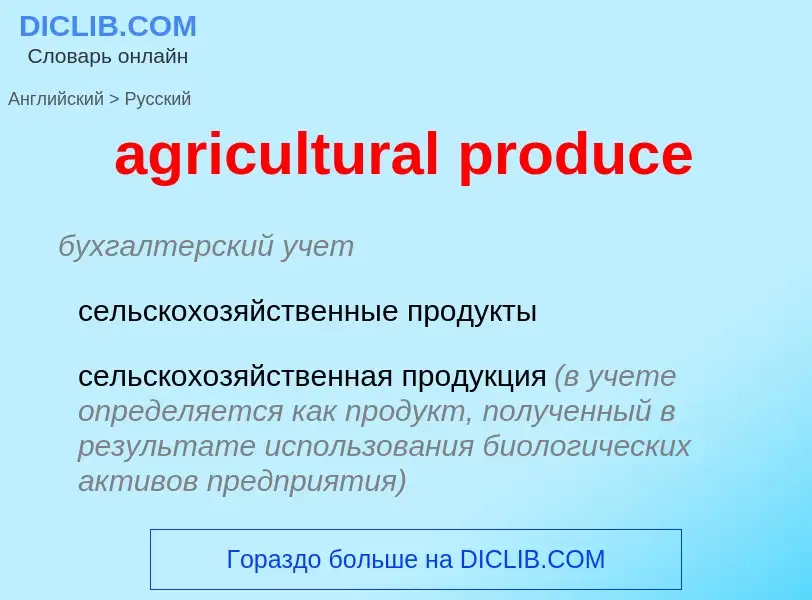Перевод и анализ слов искусственным интеллектом ChatGPT
На этой странице Вы можете получить подробный анализ слова или словосочетания, произведенный с помощью лучшей на сегодняшний день технологии искусственного интеллекта:
- как употребляется слово
- частота употребления
- используется оно чаще в устной или письменной речи
- варианты перевода слова
- примеры употребления (несколько фраз с переводом)
- этимология
agricultural produce - перевод на Английский
бухгалтерский учет
сельскохозяйственные продукты
сельскохозяйственная продукция (в учете определяется как продукт, полученный в результате использования биологических активов предприятия)
синоним
Смотрите также
общая лексика
сельхозпродукция
['ægrikʌltʃə]
общая лексика
земледелие
сельское хозяйство
агрокультура
сельскохозяйственная культура
агрономия
существительное
общая лексика
сельское хозяйство
земледелие
агрокультура
хлебопашество
агрономия
синоним
2) земледельческий; агрономический
2) земледелие; агрономия
- commercial agriculture
- continental agriculture
- crofting agriculture
- diversified agriculture
- dry agriculture
- efficient agriculture
- extensive agriculture
- farm-market agriculture
- grassland agriculture
- high agriculture
- inefficient agriculture
- intensive agriculture
- irrigated agriculture
- low agriculture
- machine agriculture
- mechanized agriculture
- nonirrigated agriculture
- scientific agriculture
- subsistence agriculture
- tank agriculture
- tray agriculture
- truck agriculture
['fɑ:miŋ]
общая лексика
выращивание
Смотрите также
существительное
общая лексика
занятие сельским хозяйством
земледелие и животноводство
сдача в аренду
на откуп
сельское хозяйство
синоним
Определение
Википедия

Agriculture encompasses crop and livestock production, aquaculture, fisheries and forestry for food and non-food products. Agriculture was the key development in the rise of sedentary human civilization, whereby farming of domesticated species created food surpluses that enabled people to live in cities. While humans started gathering grains at least 105,000 years ago, nascent farmers only began planting them around 11,500 years ago. Sheep, goats, pigs and cattle were domesticated around 10,000 years ago. Plants were independently cultivated in at least 11 regions of the world. In the twentieth century, industrial agriculture based on large-scale monocultures came to dominate agricultural output.
Today, small farms produce about a third of the world's food, but large farms are prevalent. The largest one percent of farms in the world are greater than 50 hectares and operate more than 70 percent of the world's farmland. Nearly 40 percent of agricultural land is found on farms larger than 1,000 hectares. However, five of every six farms in the world consist of less than two hectares and take up only around 12 percent of all agricultural land.
The major agricultural products can be broadly grouped into foods, fibers, fuels, and raw materials (such as rubber). Food classes include cereals (grains), vegetables, fruits, cooking oils, meat, milk, eggs, and fungi. Global agricultural production amounts to approximately 11 billion tonnes of food, 32 million tonnes of natural fibres and 4 billion m3 of wood. However, around 14 percent of the world's food is lost from production before reaching the retail level.
Modern agronomy, plant breeding, agrochemicals such as pesticides and fertilizers, and technological developments have sharply increased crop yields, but also contributed to ecological and environmental damage. Selective breeding and modern practices in animal husbandry have similarly increased the output of meat, but have raised concerns about animal welfare and environmental damage. Environmental issues include contributions to climate change, depletion of aquifers, deforestation, antibiotic resistance, and other agricultural pollution. Agriculture is both a cause of and sensitive to environmental degradation, such as biodiversity loss, desertification, soil degradation, and climate change, all of which can cause decreases in crop yield. Genetically modified organisms are widely used, although some countries ban them.



![[[Slash and burn]] shifting cultivation, Thailand [[Slash and burn]] shifting cultivation, Thailand](https://commons.wikimedia.org/wiki/Special:FilePath/An example of slash and burn agriculture practice Thailand.jpg?width=200)
![[[Mechanised agriculture]]: from the first models in the 1940s, tools like a [[cotton picker]] could replace 50 farm workers, at the price of increased use of [[fossil fuel]]. [[Mechanised agriculture]]: from the first models in the 1940s, tools like a [[cotton picker]] could replace 50 farm workers, at the price of increased use of [[fossil fuel]].](https://commons.wikimedia.org/wiki/Special:FilePath/Baumwoll-Erntemaschine auf Feld.jpeg?width=200)
![Farmyard [[anaerobic digester]] converts waste plant material and manure from livestock into [[biogas]] fuel. Farmyard [[anaerobic digester]] converts waste plant material and manure from livestock into [[biogas]] fuel.](https://commons.wikimedia.org/wiki/Special:FilePath/Biogas.jpg?width=200)

![Genetically modified]] potato plants (left) resist virus diseases that damage unmodified plants (right). Genetically modified]] potato plants (left) resist virus diseases that damage unmodified plants (right).](https://commons.wikimedia.org/wiki/Special:FilePath/CSIRO ScienceImage 382 Genetically Modified Potatoes.jpg?width=200)
![1470}}, from a manuscript of [[Pietro de Crescenzi]] 1470}}, from a manuscript of [[Pietro de Crescenzi]]](https://commons.wikimedia.org/wiki/Special:FilePath/Crescenzi calendar.jpg?width=200)
![Spraying a crop with a [[pesticide]] Spraying a crop with a [[pesticide]]](https://commons.wikimedia.org/wiki/Special:FilePath/Crop spraying near St Mary Bourne - geograph.org.uk - 392462.jpg?width=200)
![corn]] and [[sorghum]] are green (sorghum may be slightly paler). Wheat is brilliant gold. Fields of brown have been recently harvested and plowed or have lain in [[fallow]] for the year. corn]] and [[sorghum]] are green (sorghum may be slightly paler). Wheat is brilliant gold. Fields of brown have been recently harvested and plowed or have lain in [[fallow]] for the year.](https://commons.wikimedia.org/wiki/Special:FilePath/Crops Kansas AST 20010624.jpg?width=200)
![Tilling]] an arable field Tilling]] an arable field](https://commons.wikimedia.org/wiki/Special:FilePath/Fendt Tractor Ripping up Kulin.jpg?width=200)
![Intensively farmed]] pigs Intensively farmed]] pigs](https://commons.wikimedia.org/wiki/Special:FilePath/Hog confinement barn interior.jpg?width=200)
![Mexican marigold]] Mexican marigold]]](https://commons.wikimedia.org/wiki/Special:FilePath/Intercropping coconut n Tagetes erecta.jpg?width=200)

![[[Reindeer]] herds form the basis of pastoral agriculture for several Arctic and Subarctic peoples. [[Reindeer]] herds form the basis of pastoral agriculture for several Arctic and Subarctic peoples.](https://commons.wikimedia.org/wiki/Special:FilePath/Reindeer herding.jpg?width=200)
![agronomist]] mapping a plant [[genome]] agronomist]] mapping a plant [[genome]]](https://commons.wikimedia.org/wiki/Special:FilePath/Research-mapping plant genomes.jpg?width=200)

![ancient Egypt]]. Tomb of [[Nakht]], 15th century BC ancient Egypt]]. Tomb of [[Nakht]], 15th century BC](https://commons.wikimedia.org/wiki/Special:FilePath/Tomb of Nakht (2).jpg?width=200)
![[[Harvest]]ing wheat with a [[combine harvester]] accompanied by a tractor and trailer [[Harvest]]ing wheat with a [[combine harvester]] accompanied by a tractor and trailer](https://commons.wikimedia.org/wiki/Special:FilePath/Unload wheat by the combine Claas Lexion 584.jpg?width=200)

![Wheat cultivar tolerant of high [[salinity]] (left) compared with non-tolerant variety Wheat cultivar tolerant of high [[salinity]] (left) compared with non-tolerant variety](https://commons.wikimedia.org/wiki/Special:FilePath/Wheat selection k10183-1.jpg?width=200)
![[[Winnowing]] grain: [[global warming]] will probably harm crop yields in low latitude countries like Ethiopia. [[Winnowing]] grain: [[global warming]] will probably harm crop yields in low latitude countries like Ethiopia.](https://commons.wikimedia.org/wiki/Special:FilePath/Winnowing The Grain, Axum, Ethiopia (Detail) (3157508890).jpg?width=200)
